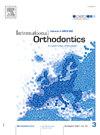操作者的经验是否会影响通过手术指南引导的腭微钉插入的准确性?体外研究
IF 1.9
Q2 DENTISTRY, ORAL SURGERY & MEDICINE
引用次数: 0
摘要
材料和方法获得了 21 个合成骨模型,这些模型来自于一个主模型,用于模拟微型螺钉插入的临床行为。通过将主模型的 CBCT 与相应的 STL 文件进行匹配,执行了数字化规划和 CAD/CAM 手术导板制造。计划在前牙旁区域插入两个腭侧微型螺钉。操作者(平均年龄 35 岁 ± 5 岁;男性 11 人,女性 9 人)被分为两个亚组(经验不足组和经验丰富组),并使用标准化程序插入微型螺钉。然后,通过将参考模型(通过数字规划得出)与 20 个工作模型(通过微型螺钉插入后的扫描得出)进行叠加,在头部和尖点水平上评估了规划微型螺钉位置与插入微型螺钉位置之间的线性和角度差异。使用单样本 Wilcoxon 检验(P < 0.05)评估绝对准确性和亚组之间的比较。结论使用 CAD/CAM 手术向导可确保经验不足的临床医生和经验丰富的临床医生之间具有可比的准确性,但经验不足的受试者之间存在一些离群差异。虽然计划的小螺钉位置与实际的小螺钉位置在准确性上存在差异,但这些差异似乎并不具有临床意义。本文章由计算机程序翻译,如有差异,请以英文原文为准。
Does operator experience affect the accuracy of guided palatal miniscrew insertion via surgical guide? An in-vitro study
Introduction
To compare the in-vitro accuracy of guided palatal miniscrew insertion comparing expert and inexpert clinicians.
Material and methods
Twenty-one synthetic bone models, derived from a single master model, were acquired to simulate the clinical act of miniscrew insertion. Digital planning and CAD/CAM surgical guide manufacturing were executed by matching the CBCT of the master model with its corresponding STL file. The insertion of two palatal miniscrews in the anterior paramedian region was planned. The operators (mean age 35 years ± 5 years; 11 males and 9 females) were divided into two sub-groups (inexperienced and experienced), and the miniscrews inserted using a standardized procedure. Linear and angular discrepancies between planned and inserted miniscrew positions were then evaluated at the level of head and tip point by superimposing the reference model (derived from digital planning) with the 20 working models (derived from scanning after miniscrew insertion). Absolute accuracy and comparison between the sub-groups were assessed using a one-sample Wilcoxon test (P < 0.05).
Results
Regardless of experience, a statistically significant difference in all investigated measurements was found. However, no statistically significant differences were detected between the two sub-groups, except for the sagittal discrepancy at the head, with the inexperienced group being less accurate (P = 0.002).
Conclusions
The use of a CAD/CAM surgical guide ensures comparable accuracy between inexperienced and experienced clinicians, excepting some outlier discrepancies among the inexpert subjects. Although there are differences in accuracy between the planned and achieved miniscrew position, these differences do not appear to be clinically significant.
求助全文
通过发布文献求助,成功后即可免费获取论文全文。
去求助
来源期刊

International Orthodontics
DENTISTRY, ORAL SURGERY & MEDICINE-
CiteScore
2.50
自引率
13.30%
发文量
71
审稿时长
26 days
期刊介绍:
Une revue de référence dans le domaine de orthodontie et des disciplines frontières Your reference in dentofacial orthopedics International Orthodontics adresse aux orthodontistes, aux dentistes, aux stomatologistes, aux chirurgiens maxillo-faciaux et aux plasticiens de la face, ainsi quà leurs assistant(e)s. International Orthodontics is addressed to orthodontists, dentists, stomatologists, maxillofacial surgeons and facial plastic surgeons, as well as their assistants.
 求助内容:
求助内容: 应助结果提醒方式:
应助结果提醒方式:


